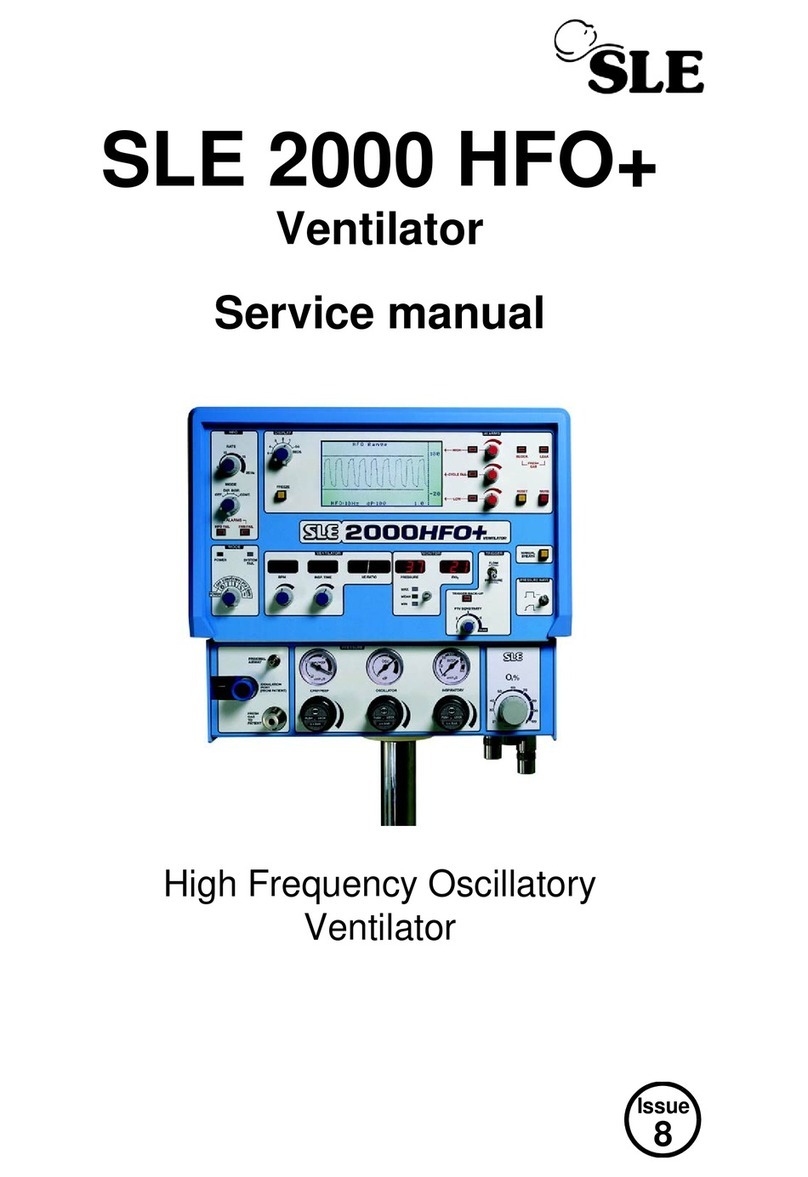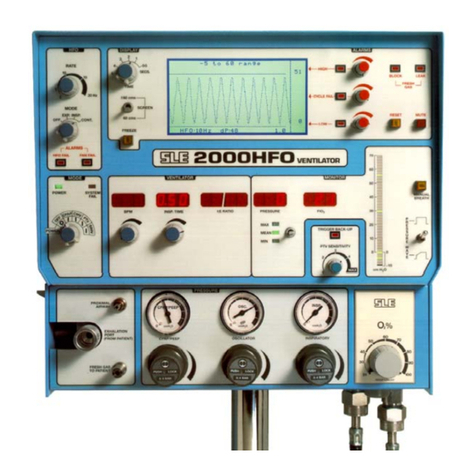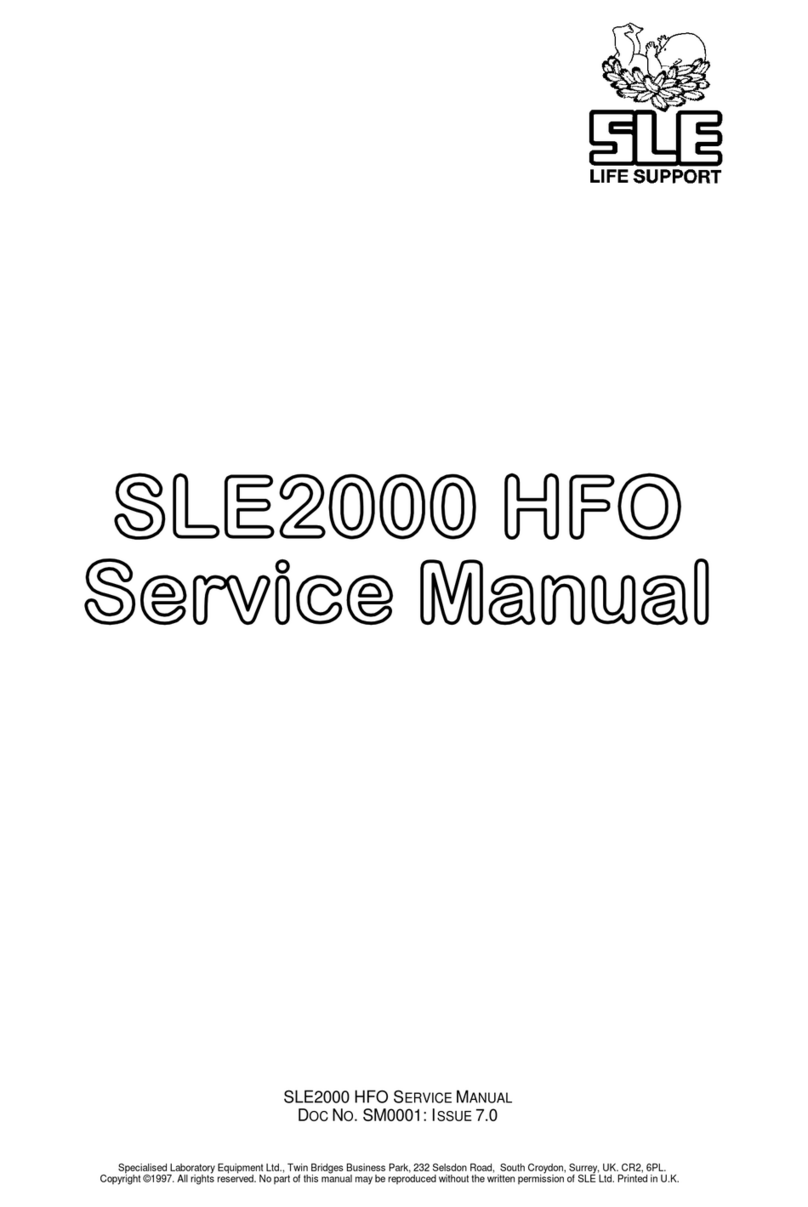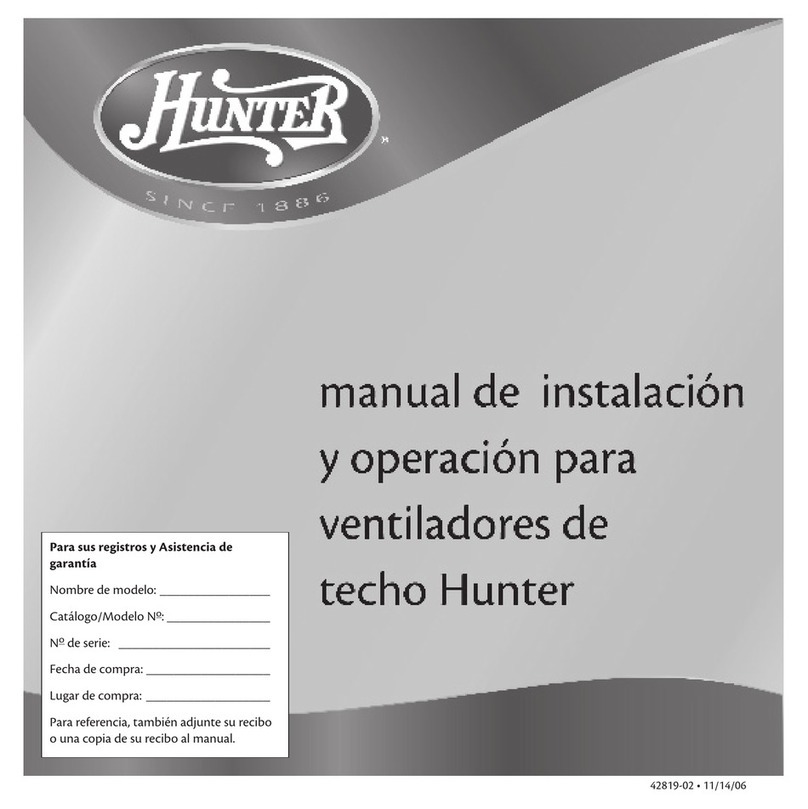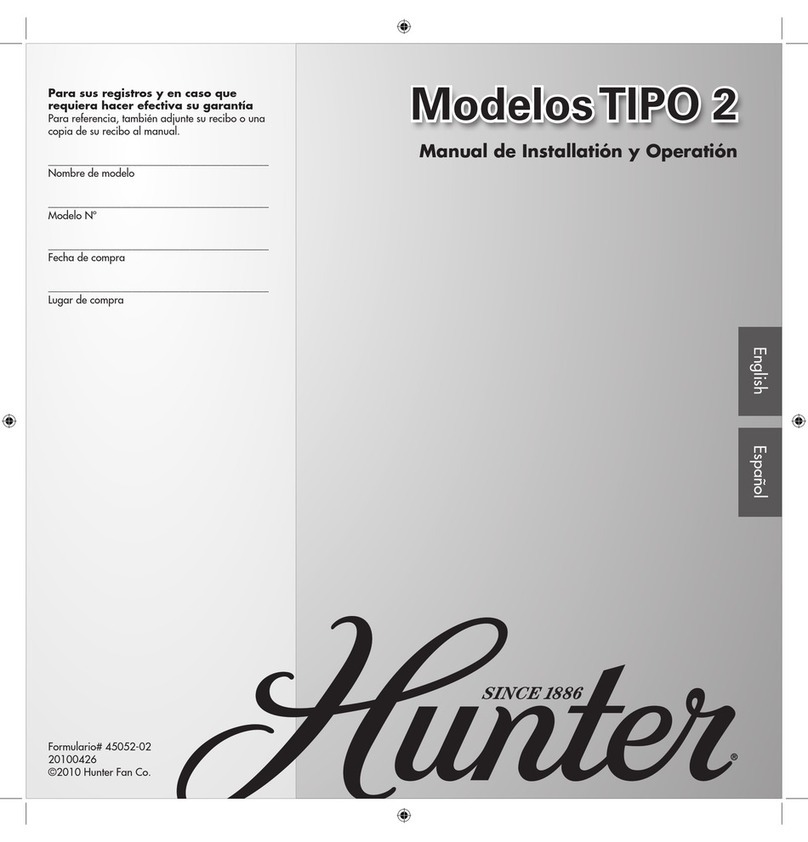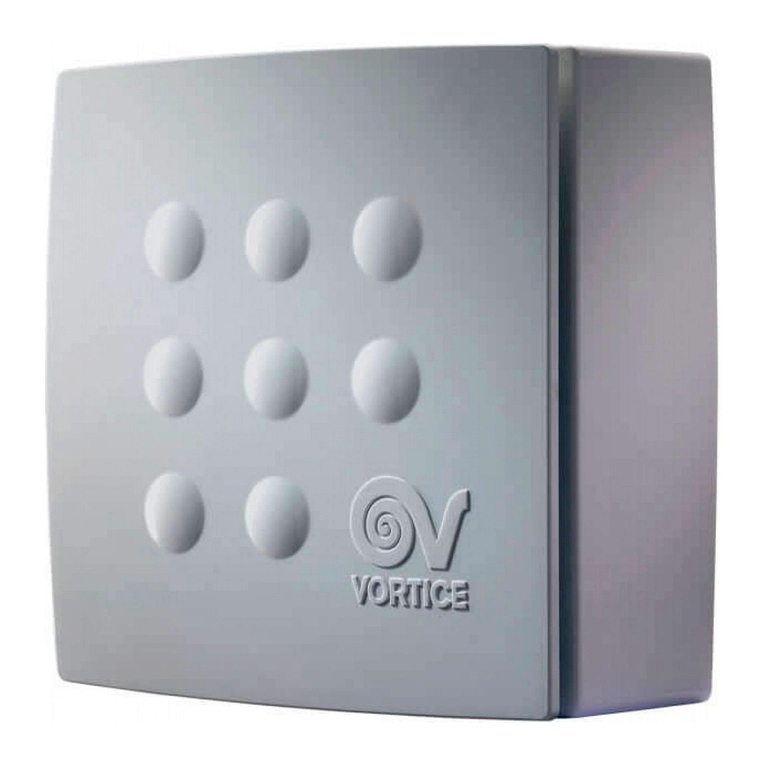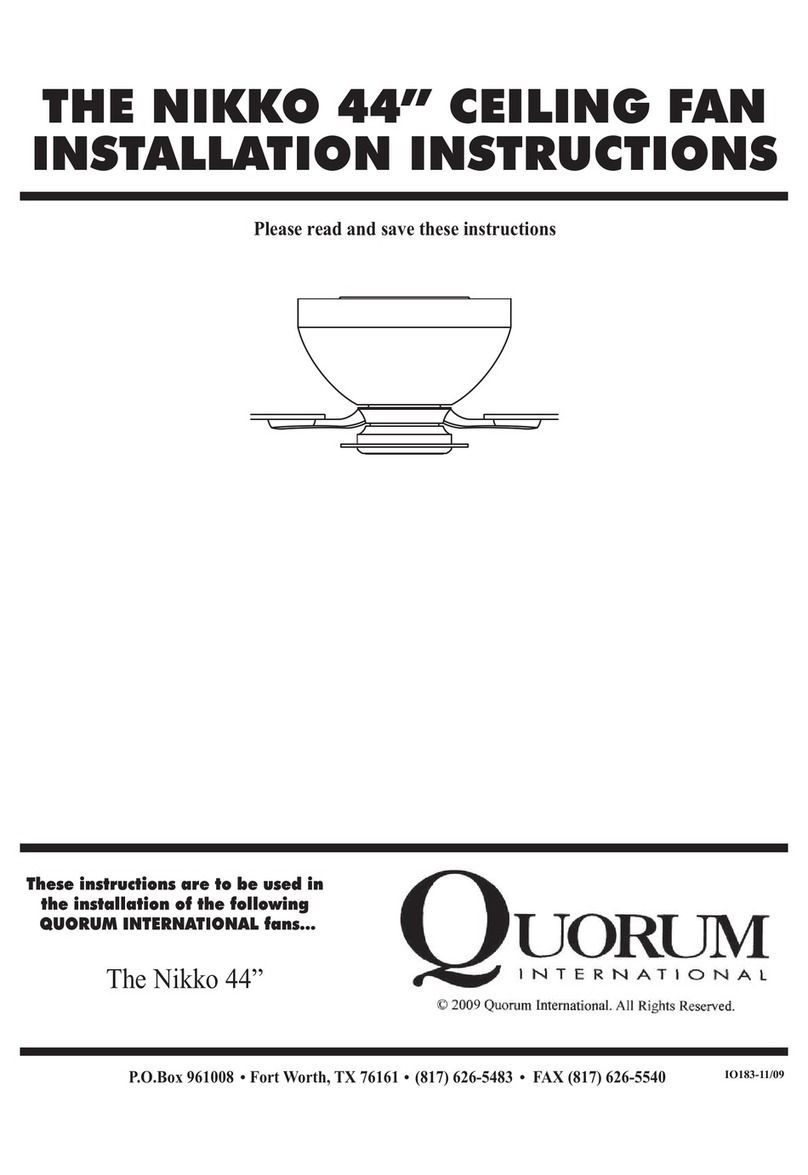SLE SLE5000 Model J User manual


Page 2 of 292
Software/Manual application Information:
Contact Information:
All rights reserved. No part of this publication may be reproduced, stored in any retrieval system, or transmitted
in any form or by any means, electronic, mechanical, photocopy, recording or otherwise, without prior
permission of SLE. © Copyright SLE 10/04/2006.
Manual : UM0083 Issue 6
SLE Part Nº: N6626/05 .
Note: This manual is to be used only with models A, B, C & D ventilators using the
following software version:
VERSION 4.1 ENGLISH / ENGLISH
SLE Limited
Twin Bridges Business Park
232 Selsdon Road
South Croydon
Surrey CR2 6PL
Telephone: +44 (0)20 8681 1414
Fax: +44 (0)20 8649 8570
Web site: www.sle.co.uk

Page 3 of 292
How To Use The
SLE5000/SLE4000 Infant Ventilator
The warnings on pages 28 to 32 must be read and understood
before using the SLE5000/SLE4000 ventilator. Failure to do so
could lead to injury or death of the patient.
1 MAKE SURE THAT THE VENTILATOR BACK-UP POWER
SUPPLY IS FULLY CHARGED: Page 134.
2 PERFORM THE FUNCTIONAL TESTS: Page 94.
3 SETUP THE VENTILATOR IN THE CHOSEN MODE: Page 154.
4 THE VENTILATOR IS READY FOR USE.
For more information see technical section, page 214.
For trouble shooting see troubleshooting chart, page 200.

Page 4 of 292
This page is intentionally blank.

Page 5 of 292
Contents
1. Introduction ...............................................................................................................14
1.1. About This Manual ...........................................................................................14
1.2. Intended Use ....................................................................................................14
1.2.1. Intended Users ..........................................................................................14
2. Description of the Ventilation Modes ......................................................................15
2.1. CPAP................................................................................................................15
2.1.1. CPAP with Apnoea Backup .......................................................................15
2.1.2. CPAP with TTV (Targeted Tidal Volume) for Back Up Breaths.................15
2.2. CMV .................................................................................................................16
2.2.1. CMV with TTV ...........................................................................................16
2.3. PTV ..................................................................................................................17
2.3.1. PTV with TTV ............................................................................................18
2.4. PSV ..................................................................................................................19
2.4.1. PSV with TTV ............................................................................................20
2.5. SIMV (Synchronized Intermittent Mandatory Ventilation).................................21
2.5.1. SIMV with PSV ..........................................................................................22
2.5.2. SIMV with TTV...........................................................................................23
2.6. HFO (SLE5000 only) ........................................................................................23
2.7. HFO+CMV (SLE5000 only) ..............................................................................23
2.8. Mode controls...................................................................................................24
2.8.1. TTV Control Mode .....................................................................................24
2.9. Technical Description .......................................................................................25
3. User/Owner Responsibility ......................................................................................26
4. Warnings ....................................................................................................................28
4.1. Operational Warnings.......................................................................................28
4.2. Clinical Warnings..............................................................................................31
5. Ventilator Description ...............................................................................................34
6. Description of Symbols and Buttons ......................................................................37
7. User Interface ............................................................................................................44
7.1. User Interface Sections ....................................................................................44
7.2. Description of User Interface Indicators ...........................................................45
7.3. Description of User Interface Controls..............................................................45
7.3.1. Examples of Control Use ...........................................................................46
7.4. Description of the Mode Panel in Ventilation Off Mode....................................48
7.4.1. Mode Panel in Ventilation Off Mode ..........................................................48
7.4.2. Mode Select Button ...................................................................................48
7.4.3. Oxygen Alarm Test ....................................................................................49
7.5. Services Panel .................................................................................................49
7.5.1. Flow ...........................................................................................................50
7.5.2. Oxygen ......................................................................................................50
7.5.3. Wave Shaping ...........................................................................................50
7.5.4. Alarm Volume ............................................................................................51

Page 6 of 292
7.6. More Options Panel ......................................................................................... 51
7.6.1. Language Toggle ...................................................................................... 52
7.7. Version Information Panel................................................................................ 53
7.7.1. Monitor Services........................................................................................ 54
7.7.2. Controller Services .................................................................................... 54
7.8. Mode Panel Functions in a Ventilation Mode................................................... 55
7.8.1. Standby Button (All modes)....................................................................... 55
7.8.2. Apnoea Setup for CPAP............................................................................ 56
7.8.3. Apnoea Setup for PTV, PSV and SIMV .................................................... 56
7.8.4. TTV for CPAP, PSV, PTV & SIMV ............................................................ 57
7.8.5. Set Trigger for CPAP, PSV, PTV & SIMV ................................................. 57
7.8.6. Pressure Support in PSV .......................................................................... 57
7.8.7. Pressure Support in SIMV......................................................................... 58
7.8.8. HFO Activity (SLE5000 Only).................................................................... 58
7.9. Alarm Panel ..................................................................................................... 59
7.10. Default Waveform Windows........................................................................... 60
7.11. Alarm and Breath Detection Thresholds ........................................................ 62
7.12. How to Set an Alarm Threshold ..................................................................... 63
7.13. Ventilation Parameters................................................................................... 66
7.14. Lung Mechanics and Measurement Panel..................................................... 68
7.15. The Pause Button .......................................................................................... 70
7.16. Night Button and Screen Lock ....................................................................... 70
8. Loops, Trends & Waveforms ................................................................................... 72
8.1. Waveforms....................................................................................................... 72
8.2. Loops ............................................................................................................... 74
8.2.1. Storing and Retrieving Loops. ................................................................... 74
8.3. Trends.............................................................................................................. 76
8.3.1. Description of Trend Windows .................................................................. 76
9. Ventilator Set-up ....................................................................................................... 78
9.1. Preparing the Ventilator for Use....................................................................... 78
9.2. Setup Related Items ........................................................................................ 82
9.2.1. Shutting Down of the Ventilator................................................................. 82
9.2.2. Back-up Battery Charging ......................................................................... 82
10. Quick Setup ............................................................................................................ 84
10.0.1. Complete Power Fail Alarm Test............................................................. 85
10.0.2. Calibration of the Flow Sensor ................................................................ 86
10.0.3. Low Oxygen Alarm Test .......................................................................... 87
10.0.4. Apnoea Alarm.......................................................................................... 89
10.0.5. Leak / Block Alarm .................................................................................. 90
10.0.6. High Pressure Alarm ............................................................................... 90
10.0.7. Low Tidal Volume.................................................................................... 90
10.0.8. Functional Test of HFO+CMV Mode ....................................................... 91
11. Functional Testing ................................................................................................ 94
11.1. Stage 1 Functional testing ............................................................................. 95

Page 7 of 292
11.1.1. Complete Power Fail Alarm Test. ............................................................95
11.1.2. Setting FiO2.............................................................................................96
11.1.3. Functional Testing with No Flow Sensor .................................................96
11.1.4. Calibration of the Flow sensor .................................................................96
11.1.5. Oxygen Alarm Test ..................................................................................98
11.1.6. Function and Alarm Testing.....................................................................100
11.1.7. High Pressure Alarm................................................................................104
11.1.8. Low Alarm................................................................................................104
11.1.9. Breath Not Detected Alarm......................................................................105
11.1.10. Leak / Block Alarm.................................................................................106
11.1.11. Mains Failure Alarm...............................................................................106
11.1.12. Gas Supply Alarms ................................................................................107
11.1.13. Flow Sensor Disconnect Alarm..............................................................108
11.1.14. Cycle Fail Alarm.....................................................................................108
11.1.15. Functional Test of HFO Mode................................................................110
11.1.16. Functional Test of HFO+CMV Mode......................................................112
11.1.17. Pressure Change Alarm ........................................................................114
11.2. Stage 2 Functional testing..............................................................................115
11.2.1. Functional Test of CMV Mode .................................................................115
11.2.2. Functional Test of PSV Mode ..................................................................120
11.2.3. Functional Test of SIMV Mode ................................................................123
12. Stage 1 Check List ..................................................................................................129
13. Stage 2 Check list ...................................................................................................131
14. Operational Considerations ...................................................................................134
14.1. General...........................................................................................................134
14.1.1. Ventilation Off Mode ................................................................................134
14.1.2. Gas Input Pressures ................................................................................134
14.1.3. Mode Memory On Power Up ...................................................................134
14.1.4. Back Up Battery Power............................................................................134
14.1.5. Parameter Memory ..................................................................................135
14.1.6. BPM or Backup, Measured and Set Parameters.....................................135
14.1.7. Tidal Volume Parameter Resolution ........................................................135
14.1.8. HFO, Mean and Delta P Parameters.......................................................135
14.1.9. Displayed FiO2.........................................................................................135
14.1.10. Breath Detection ....................................................................................136
14.1.11. Max Ti in PSV ........................................................................................136
14.1.12. TTV (Targeted Tidal Volume) ................................................................136
14.1.13. Overshoot ..............................................................................................137
14.1.14. Wave Shaping .......................................................................................137
14.1.15. Circuit Disconnection Procedure ...........................................................138
14.1.16. BPM Tot. Measurement.........................................................................139
14.2. Alarms ............................................................................................................140
14.2.1. High and Low Alarm Operation................................................................140
14.2.2. Minute Volume Alarm Threshold .............................................................141
14.2.3. Cycle Fail Alarm Threshold......................................................................141
14.2.4. Sub-ambient Pressure Alarm in Non HFO Modes...................................141

Page 8 of 292
14.2.5. HFO Only Ventilator Set Threshold Alarms (SLE5000 only)................... 142
14.2.6. Patient Leak Alarm .................................................................................. 143
14.2.7. Reset Contamination Alarm .................................................................... 143
14.3. Patient Circuits, Humidification and Nitric Oxide Therapy ............................. 144
14.3.1. Patient Circuits with Incubators, Cots and Paediatric beds..................... 144
14.3.2. Autofeed Humidification chambers.......................................................... 145
14.3.3. Nitric Oxide Therapy................................................................................ 146
14.3.4. Nebulization of Medication ..................................................................... 147
15. Flow and Pressure Triggering ............................................................................... 150
15.1. Breath Detection Threshold (Flow Triggering) ............................................... 150
15.2. Breath Trigger Sensitivity (Pressure Triggering)............................................ 151
15.3. Setting the Pressure Trigger Level in CPAP, SIMV, PTV and PSV............... 152
16. Basic Set-up ............................................................................................................ 154
16.1. Pre Set-up Checks......................................................................................... 154
16.2. Setting the FiO2............................................................................................. 155
16.3. CPAP Set-up.................................................................................................. 156
16.3.1. Actions After Connection to Patient in CPAP.......................................... 157
16.3.2. Ventilation Without a Flow Sensor Connected. ....................................... 159
16.4. CMV Set-up ................................................................................................... 160
16.4.1. Actions After Connection to Patient in CMV............................................ 161
16.4.2. Ventilation Without a Flow Sensor Connected. ....................................... 162
16.5. PTV Set-up .................................................................................................... 163
16.5.1. Actions after connection to patient in PTV .............................................. 164
16.5.2. Ventilation Without a Flow Sensor Connected. ....................................... 166
16.6. PSV Set-up .................................................................................................... 167
16.6.1. Actions After Connection to Patient in PSV............................................. 168
16.6.2. Ventilation Without a Flow Sensor Connected. ....................................... 170
16.7. SIMV Set-up................................................................................................... 171
16.7.1. Actions After Connection to Patient in SIMV ........................................... 172
16.7.2. Ventilation Without a Flow Sensor Connected. ....................................... 175
16.8. HFO Only Set-up (SLE5000 only).................................................................. 176
16.8.1. Actions After Connection to Patient in HFO ............................................ 177
16.8.2. Ventilation Without a Flow Sensor Connected. ....................................... 177
16.9. HFO+CMV Set-up (SLE5000 only) ................................................................ 178
16.9.1. Actions After Connection to Patient in HFO+CMV .................................. 179
16.9.2. Ventilation Without a Flow Sensor Connected. ....................................... 179
17. N5201 Flow Sensor ................................................................................................ 182
17.1. Calibration of the Flow Sensor....................................................................... 182
17.2. Cleaning and Sterilization .............................................................................. 184
18. Frequently Asked Questions ................................................................................. 188
18.1. Ventilator Related Questions ......................................................................... 188
18.1.1. What range of patients is the ventilator designed to ventilate? ............... 188
18.1.2. Can the ventilator be used without a flow sensor?.................................. 188
18.1.3. How often must the flow sensor be calibrated?....................................... 188

Page 9 of 292
18.1.4. What does “SENSOR CONTAMINATION” mean?..................................188
18.1.5. What is Standby mode used for?.............................................................188
18.1.6. What happens when the Pause button is pressed? ................................189
18.1.7. What is the operating time of the battery? ...............................................189
18.1.8. What is the battery charging time? ..........................................................189
18.1.9. What is the difference between PTV and PSV? ......................................189
18.1.10. When looking at the parameter settings, what do I record? ..................189
18.1.11. Where do I set the Trigger Sensitivity?..................................................189
18.2. Mode Related Questions................................................................................190
18.2.1. What is meant by Targeted Tidal Volume?..............................................190
18.2.2. What are appropriate Tidal Volumes? .....................................................190
18.2.3. What is the meaning of Compliance and Resistance? ............................190
18.2.4. How do I minimise the Apnoea alarm in CPAP? .....................................190
18.2.5. In TTV some of the breaths exceed the set TTV. Why?..........................190
18.2.6. Why is there no SET value for MAP and dp in HFO mode?....................191
18.3. Patient Circuits ...............................................................................................191
18.3.1. What is the difference between the N2188 and N5188 patient circuit? ...191
18.3.2. Why is a restrictor necessary?.................................................................191
18.3.3. What is a /02 patient circuit?....................................................................191
18.3.4. What is a /850 patient circuit?..................................................................191
18.3.5. What happens if the restrictor is placed in the expiratory limb instead
of the inspiratory limb?..........................................................................................191
18.3.6. Should bacterial filters be used on the expiratory limb? ..........................191
18.3.7. When using the INOSYS Nitric Oxide therapy and the ventilator what
scavenging filters do I need? ................................................................................191
18.3.8. How often does the exhalation block and silencer need to be
autoclaved? ..........................................................................................................192
18.3.9. How do I clean the exhalation block and scavenging system after using
NO? ......................................................................................................................192
19. Commonly Seen Alarms .........................................................................................194
19.0.1. High Pressure Alarm................................................................................194
19.0.2. Low Pressure Alarm ................................................................................194
19.0.3. Breath Not Detected ................................................................................194
19.0.4. Low Tidal Volume ....................................................................................194
19.0.5. Unexpected Rise or drop in Mean P (SLE5000 only) ..............................195
19.0.6. Unexpected Rise or Drop in Max P (SLE5000 only)................................195
19.0.7. Unexpected Rise or Drop in Min P (SLE5000 only).................................195
19.0.8. Continuing Positive Pressure...................................................................195
19.0.9. Leaking Fresh Gas ..................................................................................195
19.0.10. High Patient Leak ..................................................................................196
19.0.11. Clean Flow Sensor ................................................................................196
19.0.12. Faulty Flow Sensor ................................................................................196
19.0.13. Calibration Fail.......................................................................................197
19.0.14. Calibrate Flow Sensor ...........................................................................197
19.0.15. Apnoea (volume) ...................................................................................197

Page 10 of 292
20. Trouble Shooting Chart ......................................................................................... 200
20.1. Ventilator Related Problems .......................................................................... 200
20.2. Ventilation Related Problems......................................................................... 209
21. Oxygen Calibration Routines ................................................................................ 214
21.1. One Point O2Calibration ............................................................................... 214
21.2. Two Point O2Calibration ............................................................................... 214
22. Preventative Maintenance and Overhaul Schedule ............................................ 215
23. RS232 ......................................................................................................................216
23.1. Warnings for RS232....................................................................................... 216
23.2. Location of RS232 Port.................................................................................. 216
23.3. Overview ........................................................................................................ 217
23.3.1. Data and Pinout Description.................................................................... 217
23.3.2. Cable....................................................................................................... 217
23.3.3. Parameter Descriptions and Format ....................................................... 218
23.3.4. List of Parameters ................................................................................... 218
23.3.5. Table of Current Alarm Condition Codes. ............................................... 221
23.4. RS232 Connection Settings and Testing Data Output................................... 223
24. Alarms .....................................................................................................................224
24.1. Alarm Protocols.............................................................................................. 224
24.2. Alarm Sounds ................................................................................................ 224
24.3. Alarm Descriptions and Actions to be Taken ................................................. 225
24.4. Software and System Fail Protocols .............................................................. 244
25. Bacterial Filters ...................................................................................................... 245
25.1. Bacterial filter, SLE Part Nº:N2029 (Autoclavable) ........................................ 245
25.2. Bacterial filter, SLE Part Nº: N2587 (Single use) ........................................... 246
25.2.1. Precautions When Using Bacterial Filter N2587 ..................................... 246
26. Patient Circuits ....................................................................................................... 247
26.1. Warnings for Patient Circuit Use.................................................................... 247
26.2. 10mm Diameter Re-usable Patient Circuit (SLE Part Nº N2391/50) ............. 248
26.2.1. Sterilising of the N2391/50 re-usable Patient Circuit............................... 248
26.3. 10mm Patient Circuit, SLE Part Nº N5188 & N5188/850.............................. 250
26.4. 10mm Patient Circuit, SLE Part Nº N5188/02 & N5188/02/850..................... 252
26.5. N5238/50 Heated Patient Circuit For NO Therapy ........................................ 254
26.6. Nitric Oxide Delivery Adaptor Kit (SLE Part Nº N2238/50) ............................ 256
27. Cleaning, Disinfection and Sterilization ............................................................... 257
27.1. Preparation of a New Ventilator ..................................................................... 257
27.2. Cleaning and Disinfection of an In-service Ventilator .................................... 257
27.2.1. Cleaning, Disinfection & Sterilization Chart............................................. 258
27.3. Cleaning Method............................................................................................ 258
27.4. Disinfection Method ....................................................................................... 259
27.5. Sterilization Method ....................................................................................... 260

Page 11 of 292
28. Technical Specification ..........................................................................................261
28.1. Operating Modes Conventional Ventilation ....................................................261
28.1.1. CPAP .......................................................................................................261
28.1.2. CMV.........................................................................................................261
28.1.3. PTV..........................................................................................................261
28.1.4. PSV..........................................................................................................262
28.1.5. SIMV ........................................................................................................262
28.2. HFO Ventilation ..............................................................................................262
28.2.1. HFO Only.................................................................................................262
28.2.2. HFO+CMV ...............................................................................................262
28.2.3. Controls (Via touch screen display) .........................................................263
28.2.4. Controls ...................................................................................................266
28.3. Measurement .................................................................................................266
28.3.1. Flow and Volume .....................................................................................266
28.3.2. Oxygen Concentration .............................................................................266
28.3.3. Pressure ..................................................................................................267
28.4. Alarms ............................................................................................................268
28.4.1. User settable Alarms ...............................................................................268
28.4.2. Obligatory Alarms (non adjustable by user).............................................269
28.5. Patient circuits ................................................................................................269
28.6. Outputs...........................................................................................................270
28.7. Gas supplies...................................................................................................271
28.7.1. Oxygen supply .........................................................................................271
28.7.2. Air supply .................................................................................................271
28.7.3. Flows .......................................................................................................271
28.8. Power, Dimensions, Standards etc. ...............................................................272
28.9. Environmental Storage Conditions.................................................................272
29. Pneumatic Unit Schematic .....................................................................................273
30. Ventilator Labelling .................................................................................................274
30.1. SLE4000.........................................................................................................274
30.2. SLE5000.........................................................................................................275
31. Consumables and Accessories .............................................................................278
32. Glossary of Abbreviations Used in this Manual ..................................................284
33. Index .........................................................................................................................287

Page 12 of 292
This page is intentionally blank.

Page 13 of 292
Introduction

Page 14 of 292
1. Introduction
1.1 About This Manual
This user manual details the operation of the SLE4000 and SLE5000 infant ventilators. The
difference between an SLE4000 and SLE5000 ventilator is that the SLE5000 has two extra
modes of operation, these being HFO and HFO+CMV.
The user manual will from this point onwards refer to the SLE4000 and SLE5000 as
“the ventilator”.
Where the user manual details an operation or mode: specifically HFO or HFO+CMV then a
statement will appear stating, “SLE5000 only”.
The SLE4000 and SLE5000 model A infant ventilators are identical except for the following,
A. Overlays. (SLE5000 overlays are blue, SLE4000 overlays are green).
B. Installed software. (Start up screens and Mode select panels.)
Note: HFO and HFO+CMV modes are not available on the SLE4000 infant
ventilator.
Note: All the graphics within this manual have been produced with the N6647
test lung and are not representaive of actual clinical data.
1.2 Intended Use
The ventilator is designed for use on patients up to 20kg, in conventional ventilation. In high
frequency oscillation ventilation up to 20kg, dependant on lung condition (SLE5000 only).
1.2.1 Intended Users
The ventilator is to be used by appropriately trained and authorised personnel only. In this
manual they will be referred to as the “User”.

Page 15 of 292
2. Description of the Ventilation Modes
The ventilator has the ability to be used as either a pressure controlled, volume targeted
ventilator, as a pressure limited, time cycled ventilator, and the SLE5000 as a high frequency
oscillation ventilator.
2.1 CPAP
Continuous Positive Airway Pressure
The ventilator generates a continuous positive airway pressure at a level set by the User.
The apnoea alarm will sound if the patient has not made any breath attempts within the set
apnoea period.
User sets the following:-
•CPAP
• Apnoea time
• Manual Breath parameters (Ti and PIP)
•Fi0
2
• Flow breath detection threshold (Set Trigger) - The patient effort required to satisfy
the apnoea alarm.
• High and low pressure alarm thresholds
• Tidal volume, high and low alarm thresholds
• Minute volume, high and low alarm thresholds
2.1.1 CPAP with Apnoea Backup
This is as for basic CPAP mode but if the patient does not make a breath attempt within the
Apnoea time then a pressure limited, time cycled backup breath is provided.
The User turns ON the backup breaths function.
2.1.2 CPAP with TTV (Targeted Tidal Volume) for Back Up Breaths.
This is as for basic CPAP with or without Apnoea Support, where the inspiratory phase shall
be terminated if the set volume has been delivered by the back up breath.
The User sets the following:-
• Enables Targeted Tidal Volume (Tidal Vol) and selects volume to be delivered
•MaxPIP
•MaxTi

Page 16 of 292
2.2 CMV
Continuous Mandatory Ventilation
In this mode the inspiratory cycle is initiated by the ventilator at a set BPM rate. The breaths
can be either time limited and pressure cycled or flow cycled and pressure limited.
The User sets the following:-
•BPM
• Positive End Expired Pressure (PEEP)
• Peak Inspiratory Pressure (PIP)
• Inspiratory Time (Ti)
•Fi0
2
• High and low pressure alarm thresholds
• Tidal volume, high and low alarm thresholds
• Minute volume, high and low alarm thresholds
2.2.1 CMV with TTV (Targeted Tidal Volume)
This is as for basic CMV, but where the inspiratory phase shall be terminated when the set
volume has been delivered.
The User sets the following:-
• Enables Targeted Tidal Volume (Tidal Vol) and selects volume to be delivered
•MaxPIP
•MaxTi

Page 17 of 292
2.3 PTV
Patient Triggered Ventilation
In this mode all the patient's breath attempts are pressure supported. Mechanical breaths
are delivered at the set parameters (Ti, PEEP and PIP) if no patient effort is recognised. This
mode can be used with or without a flow sensor.
The User sets the following:-
• Positive End Expired Pressure (PEEP)
• Peak Inspiratory Pressure (PIP)
• Inspiratory Time (Ti)
• Backup breath rate (Backup)
• Apnoea Time (Only if backup breath rate is 19 breaths per minute or lower)
•Fi0
2
• Flow breath detection threshold (Set trigger) - The patient effort required to satisfy
the apnoea alarm.
• High and low pressure alarm thresholds
• Tidal volume, high and low alarm thresholds
• Minute volume, high and low alarm thresholds
PTV Flow and Tidal volume waveforms.

Page 18 of 292
Note: PTV will continue to function as stated, but with breath rates of 20 and
above apnoea alarms will be ignored by the ventilator. Breath rates of 20BPM
and above are deemed sufficient to support the patient. Should the breath
rate be set below 20BPM the apnoea alarm is enabled.
2.3.1 PTV with TTV (Targeted Tidal Volume)
This is as for basic PTV where the inspiratory phase shall be truncated when the set volume
has been delivered for mechanical back up breaths only.
The User sets the following:-
• Enables Targeted Tidal Volume (Tidal Vol) and selects volume to be delivered
•MaxPIP
•MaxTi

Page 19 of 292
2.4 PSV
Pressure Supported Ventilation
This is a pressure limited mode of ventilation in which each breath is patient triggered and
supported. The breath is patient triggered, pressure supported and patient terminated. The
infant therefore has control of the whole cycle, i.e. the inspiratory time, frequency and minute
volume. This form of ventilation is dependant on the use of a flow sensor placed between the
ET tube connector and the patient circuit. Changes in flow or volume signal detects
spontaneous breathing.
The termination sensitivity is also user adjustable from 0% - 50%. 5% termination sensitivity
means that 95% of the peak flow has been achieved. Pressure support can be manually
adjusted by use of the PIP parameter control.
Note: If the user sets the termination sensitivity to OFF the PSV mode
behaves as PTV.
PSV can be used in the weaning process. Weaning is achieved by reducing the support
level as the infant is able to make more effort.
In this mode all the patient's breath attempts are pressure supported, but mechanical
breaths are delivered at the set parameters (Ti, PEEP and PIP) when a patient effort is
recognised.
The User sets the following:-
• Positive End Expired Pressure (PEEP)
• Peak Inspiratory Pressure (PIP)
• Inspiratory Time (Ti)
• Backup breath rate (Backup)
• The flow termination sensitivity
• Apnoea Time (Only if backup breath rate is 19 breaths per minute or lower)
•Fi0
2
• Flow breath detection threshold (Set Trigger) - The patient effort required to satisfy
the apnoea alarm.
• High and low pressure alarm thresholds
• Tidal volume, high and low alarm thresholds
• Minute volume, high and low alarm thresholds

Page 20 of 292
PSV Flow and Tidal volume waveforms (with termination sensitivity).
Note: PSV will continue to function as stated, but with breath rates of 20 and
above apnoea alarms will be ignored by the ventilator. Breath rates of 20BPM
and above are deemed sufficient to support the patient. Should the breath
rate be set below 20BPM the apnoea alarm is enabled.
2.4.1 PSV with TTV (Targeted Tidal Volume)
This is as for basic PSV where the inspiratory phase shall be truncated when the set volume
has been delivered, (for mechanical back up breaths).
The User sets the following:-
• Enables Targeted Tidal Volume and selects volume to be delivered
•MaxPIP
•MaxTi
Other manuals for SLE5000 Model J
1
This manual suits for next models
1
Table of contents
Other SLE Fan manuals
Popular Fan manuals by other brands

Kooper
Kooper 2193305 manual

Home Decorators Collection
Home Decorators Collection 51662 Use and care guide
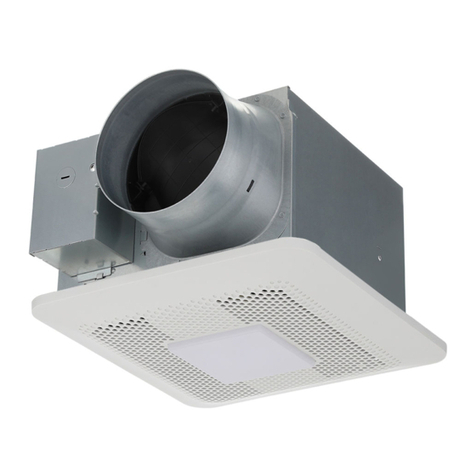
Panasonic
Panasonic RG-C1315LA Service manual
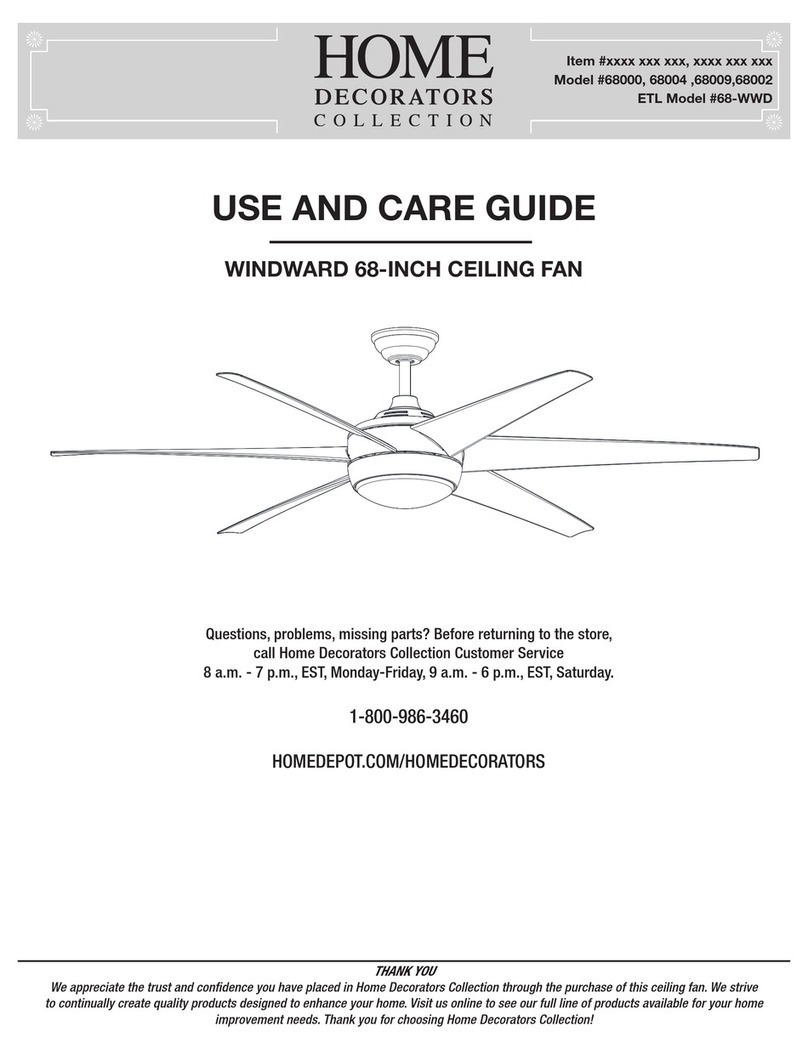
Home Decorators Collection
Home Decorators Collection WINDWARD 68-WWD Use and care guide

TroposAir
TroposAir 5HA52 owner's manual
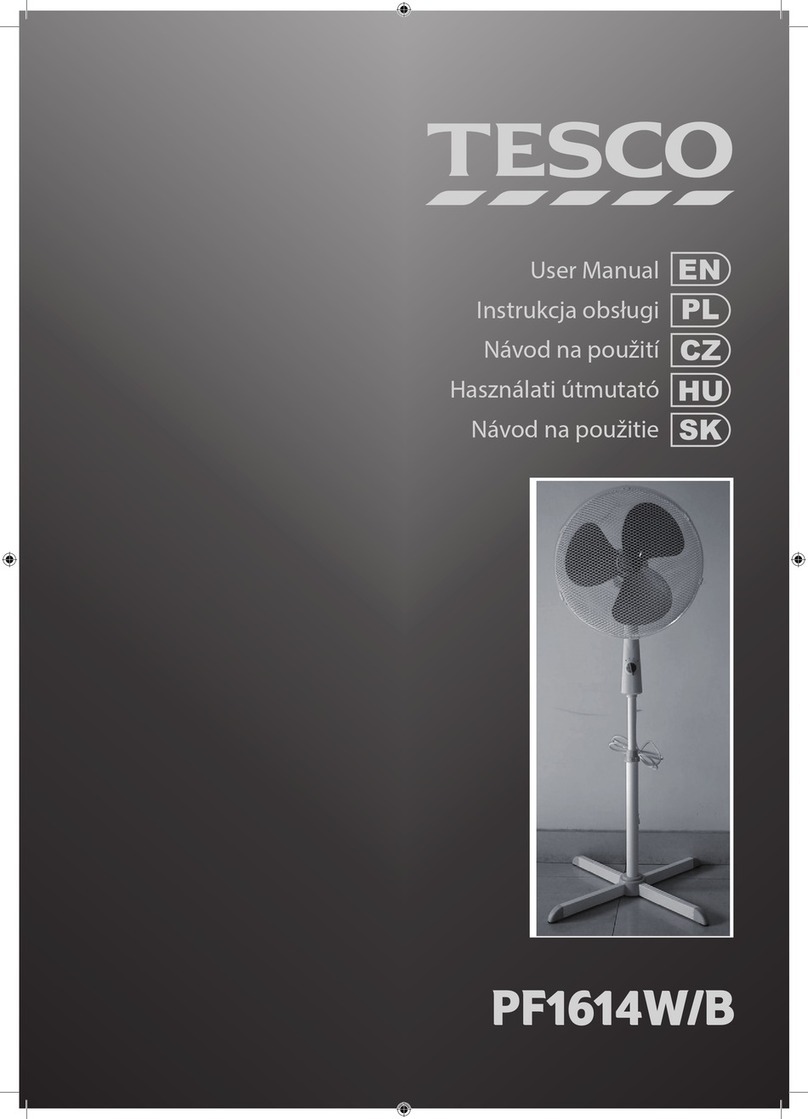
Tesco
Tesco PF1614W user manual
